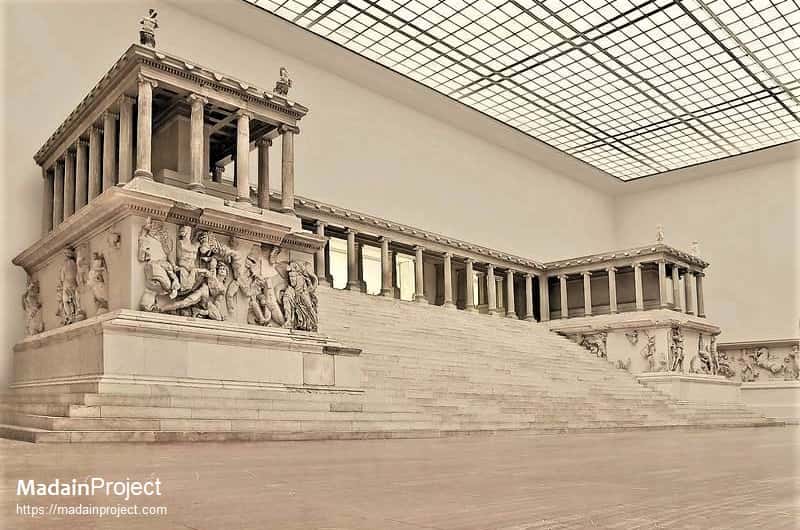Glenn Maffia
On reading about the investigation into the legality of the acquisitions purloined by early German archaeologists during the late 19th and early 20th centuries my initial thought was this.
If these antiquities had not been removed from their original locations at that time they would have probably not survived into our current age.
The stone would have been invariably recycled into building materials for abodes, animal pens (plenty of evidence of that occurring in Didyma) or even burnt for the production of lime to be used in the aggregate for mortar.
The Ottoman Empire and the fledgling Republic of Türkiye were certainly not conducive to the economic advantages of mass tourism, so critical and essential to modern Türkiye’s intrinsic financial well-being today.
The illusion that this so-called ‘Division of Antiquities’ was a fair share of the spoils from the German’s excavations was probably lubricated by hard German currency. Certainly, any remnants of ancient stone artefacts would not have any allure for the fabulously rich Sultans, but another input of cash would not have gone amiss.
There was an eminent Ottoman archaeologist, intellectual, administrator and fine art painter Osman Hamdi Bey, director of İstanbul’s Royal Museum, who was avid about protecting antiquities. But such noble sentiments would not have percolated into many local minds or within the overall fabric of societal values. Therefore, interest would have been akin to non-existent, even dismissive. An attitude still prevalent today?
Protection and health of exhibits
Certainly the appeal of once again observing antiquities in situ is of immense importance in understanding the original context. I have no qualms about a faithful observance in endeavouring to achieve this admirable aim.
The trouble is when, as I have been bemoaning incessantly, the Turkish archaeologists continue to merely dabble in, what an Italian friend has described as, ‘Disney archaeology’.
In attempting to, ineptly, ‘reconstruct’ ancient structures this practice explicitly divorces the structure from its history, its living past and ultimately its dignity. Such noble buildings now merely appear as the pastiche they have degraded into.
If indeed this repatriation does occur the artefacts inevitably shall be removed from the fabulous museums within Germany which have housed them for a century or more.
I am extremely dubious if some of these larger structures (the Pergamon Altar, the Milesian Market Gate etc.) would fare well if placed in their original locations; open to the elements after residing within an environmentally controlled atmosphere for so long a time.
Professional advice must urgently be sought to ensure the future well-being of the antiquities; suitability to proposed locations, maintenance and protection proposals, access to all visitors and guards to ensure security of these treasures. The latter particularly pertinent given the present economic situation within Türkiye and a voraciously greedy and hungry antiques black market.
My belief is that the artefacts must be in, at least, the vicinity whence they were ‘born’, otherwise they may well have remained in Berlin, and elsewhere, if they are not able to be so. By obvious conclusion this shall entail a significant building project of upgrading and/or enlarging many provincial museums. Is this politically feasible, given the recent traumas occurring in eastern Türkiye?
Geographical and Historic context
‘In situ’ is a significantly important point as it remains at the entire crux, the kernel, of Türkiye’s bid for ‘repatriation’, at least in my viewpoint.
Certainly my Turkish friends have long protested these artefacts were stolen/looted from Türkiye. I have to concede that the waters are very murky herein and that a number of acquisitions have the stench of Western Imperialism.
It certainly was known that bribery within the circles of late Ottoman officials was not unheard of, it may have even been rife. Money changed hands, but was the ‘firman’, a paper indicating official confirmation from the Sultan, genuine?
The late Ottoman Empire was in a state of irreversible decay, fracturing fast. Given that Europe considered Ancient Greece and the Roman Empire as constituting the bedrock of their societies and imbuing its values, is it any wonder that the acquisitions were voraciously sought to confirm such imperious aspirations upon their countries?
The Ottomans, and later the people of the Republic of Türkiye, came from an entirely different background which had no such illusions, it meant nothing to them and their cultural institutions. Again, still a perceptible mode in the present, outside of a few.
There was life before Greece
Of course, the ancient Greeks were not indigenous to the land we refer to as Anatolia today, as many wish to attest. Nor certainly the Romans, who were gifted the Kingdom of Pergamon by their last king, Attalus III during 133 BCE.
There were many other peoples preceding the initial gradual Greek colonisation; too numerous to mention them all, but I urge you to research the Hatti, the powerful Hittite peoples, the Lydians, the Lycians, Carians, Uratians, Commengians, I could go on ad infinitum. Not everything started with the Greeks, therefore, be wary of Western European chronology.
Whilst please be aware of the recent revelations of sophisticated peoples residing within the Fertile Crescent of Eastern Anatolia in the multitude of Taş Tepeler (Stone Hills), thousands of years before recorded history. Göbeklitepe probably being the best known. History can be selective in its propaganda, and not particularly accurate.
Therefore, I believe that it is a pertinent question to ask if a particular present day nation can claim ownership of an ancient artefact? Surely it is conclusively not, in my humble opinion. These are the collected antiquities belonging to humankind, whose preservation is for the benefit of our intellectual consciousness of the ever-changing past to this very day. It cannot be owned, it can only be shared.
Consider how differently and more reverential people approach exhibits within a museum environment. The consideration and empathy of origin usurp such mundane and irreverent frivolous items such as man-made lines drawn upon the globe delineating fields of current ownership. That has absolutely zilch to understanding the history of humanity.
